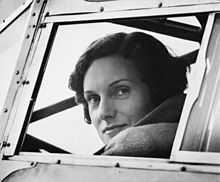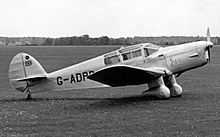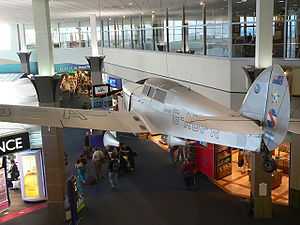Jean Batten
| Jean Batten | |
|---|---|
 Jean Batten in 1937 | |
| Full name | Jean Gardner Batten |
| Born |
15 September 1909 Rotorua, New Zealand |
| Died |
22 November 1982 (aged 73) Palma, Majorca, Spain |
| Cause of death | Complications following dog bite |
| Nationality | New Zealand |
| Aviation career | |
| Known for | Record breaking trans-world flights |
Jean Gardner Batten CBE OSC (15 September 1909 – 22 November 1982) was a New Zealand aviator. Born in Rotorua, she became the best-known New Zealander of the 1930s, internationally, by taking a number of record-breaking solo flights across the world. It was she who in 1936 made the first-ever solo flight from England to New Zealand.
Biography
Jean Batten was the daughter of a dental surgeon named Frederick Batten and a mother named Ellen Batten who became a strong supporter of her career as a pilot. In 1924 she was enrolled into a girls' boarding college in Remuera in Auckland where she studied ballet and piano. Though she was a gifted pianist, at the age of 18 she wanted to become a pilot, inspired by the Australian Charles Kingsford Smith, who took her for a flight in his Southern Cross. In 1929 she moved to England with her mother to join the London Aeroplane Club. She took her first solo flight in 1930 and gained private and commercial licences by 1932, borrowing £500 from Fred Truman, a New Zealand pilot serving in the Royal Air Force who wanted to marry her, to fund the 100 hours flying time required. After completing her "B" license in December 1932, she left Truman and turned to Victor Dorée, who borrowed £400 from his mother to buy Batten a Gipsy Moth biplane. According to NZ History Online, "Raising money by taking advantage of her relationships with men was a theme that continued throughout her flying career."[1]
Batten made two unsuccessful attempts to beat Amy Johnson's time to Australia. In April 1933 she hit two sandstorms before the engine failed, and wrecked the aircraft. She crash-landed near Karachi. Returning to London she could not persuade Dorée to buy her another aircraft, so she turned to the Castrol oil company, who bought her a second-hand Gipsy Moth for £240. She made another attempt in April 1934, but ran out of fuel at night on the outskirts of Rome. Flying into a maze of radio masts, she crash landed and nearly severed her lip. The plane was repaired and she flew it back to London, where she borrowed the lower wings from the aircraft of her fiancé, stockbroker Edward Walter, for a third attempt.[2]
In May 1934, Batten successfully flew solo from England to Australia in the Gipsy Moth. Her trip of 14 days and 22 hours beat the existing England-to-Australia record of English aviator Amy Johnson by over four days.[2] For this achievement and for subsequent record-breaking flights, she was awarded the Harmon Trophy three times from 1935 to 1937. She also received an endorsement contract with Castrol oil. Batten's book about her trip, Solo Flight, was published by Jackson and O'Sullivan Ltd in 1934. Batten took a boat to New Zealand with the Gipsy Moth (which could not have flown across the Tasman Sea) and made a six-week aerial tour there before returning to England.

After her first Australia flight Batten bought a Percival Gull Six monoplane, G-ADPR, which was named Jean. In 1935 she set a world record flying from England to Brazil in the Gull, for which she was presented the Order of the Southern Cross, the first person other than Royalty to be so honoured.[3] In 1936 she set another world record with a solo flight from England to New Zealand. At her birthplace of Rotorua she was honored by local Māori, as she had been after the 1934 journey. She was given a chief’s feather cloak and given the title Hine-o-te-Rangi – "Daughter of the Skies". Batten was created Commander of the British Empire (CBE) in 1936, and she was also given the Cross of Chevalier of the French Legion of Honour that year. Also in 1936, for the second successive year, Batten was again awarded the Royal Aero Club's Britannia Trophy for most meritorious performance in aviation during the previous year.
In 1938, she was the first woman to be awarded the medal of the Fédération Aéronautique Internationale, aviation's highest honour. Throughout the 1930s she was very social and made many friends with other aviators internationally, as she described in her autobiography.
World War II ended Batten's flying adventures. Her Gull was commissioned to active service but Batten was not permitted to fly it. During the war she was involved in campaigns giving lectures in England to raise money for guns and aeroplanes, but her flying days were over. After the war she retired from public life except for a few anniversary appearances.[4]
Batten became a recluse and lived in several places around the world with her mother until her mother's death in 1965. In 1977 she was guest of honour at the opening of the Aviation Pioneers Pavilion at Auckland's Museum of Transport and Technology, after which she returned to her home in Spain.[5] In 1982 she was bitten by a dog on the island of Majorca. She refused treatment and the wound became infected.[6] She died alone in a hotel on Majorca, from complications from the dog bite, and was buried on 22 January 1983 in an anonymous grave. A bureaucratic error, however, meant that neither relatives, nor most of the world, learned of her death until September 1987.[7]
Batten's autobiography, My Life, was published by George G. Harrap in 1938 and is now available in full online at the New Zealand Electronic Text Center, part of the Victoria University of Wellington Library. An extended version was printed under the title Alone in the Sky by N.Z. Technical books in 1979.
Because of her striking looks, her glamorous appearance at receptions (she always took a dress with her on her record-breaking flights), and her later reclusive ways, Batten became known as the "Greta Garbo of the skies". In October 2008 a musical Garbo of the Skies written by Paul Andersen-Gardiner and Rebekah Hornblow had its inaugural performance in Opunake by the Opunake Players at the Lakeside Playhouse. This was based on Ian Mackersey's biography.
Legacy

Houses in Macleans College, Howick Intermediate, Pukekohe Intermediate School, Westlake Girls High School, Southland Girls' High School, Forrest Hill School, Tauranga Girls' College and Wellington Girls' College are named after her, as is Batten (Blue) House at Orewa College and in the whanau system of Aorere College in South Auckland. A primary school in Mangere is named after her as are streets in Auckland, Christchurch, Mount Maunganui, Wellington, Wallington and in her birthplace of Rotorua. The historic Jean Batten building on the corner of Fort and Shortland streets in Auckland has been incorporated into the new Bank of New Zealand head office building, and the Auckland Airport International Terminal is named after her. The Percival Gull G-ADPR in which she made the first ever solo trip from England to New Zealand in 1936 and many other record-breaking trips now hangs in the Jean Batten International Terminal.
A bronze sculpture of Batten is located in the main terminal of Rotorua Airport and a small park in the middle of Rotorua city is also named after her.
In September 2009, a Qantas 737-800 ZK-ZQA, the first International configuration plane of its type and Qantas's 75th 737 was named after Batten.[8]
During the 1980s Britannia operated 737-200 G-BGYL, named Jean Batten. It later crashed in Panama after being sold to COPA.
Major flights
- 1934 – England - Australia (women's record) 10,500 miles in 14 days 22 hours 30 minutes, breaking Amy Johnson's record by over four days.[2]
- 1935 – Australia - England in 17 days 15 hours. First woman ever to make a return flight.
- 1935 – England - Brazil: 5000 miles in 61 hours 15 minutes, setting world record for any type of aeroplane. Also fastest crossing South Atlantic Ocean, 13¼ hours, and first woman to make England - South America flight.
- 1936 – England - New Zealand. World record for any type. 14,224 miles in 11 days 45 minutes total elapsed time, including 2½ days in Sydney.
List of honours
_Ribbon.png) Commander of the Order of the British Empire (Great Britain)
Commander of the Order of the British Empire (Great Britain)-
_Ribbon.png) Officer of the Order of the Southern Cross (Brazil)
Officer of the Order of the Southern Cross (Brazil) -
 Chevalier de la Légion d'Honneur (France)
Chevalier de la Légion d'Honneur (France) -
 King George VI Coronation Medal
King George VI Coronation Medal
References
- ↑ NZ History Online - Jean Batten
- ↑ 2.0 2.1 2.2 Mackersey, Ian. "Batten, Jean Gardner 1909–1982". Dictionary of New Zealand Biography. Ministry for Culture and Heritage. Retrieved 11 May 2010.
- ↑ My Life, by Jean Batten, George G. Harrap & Co. Ltd., 1938
- ↑ "Jean Batten Bio (compilation)". Monash University Centre for Telecommunications and Information Engineering. Retrieved 23 December 2012.
- ↑ Jean Batten Hine-o-te-Rangi: Daughter of the skies
- ↑ "Jean Batten - A Female Pilot". New-zealand-vacations-in-west-auckland.com (Beate Cisse). Retrieved 23 December 2012.
- ↑ Mackersey, Ian. "Batten, Jean Gardner 1909–1982". Dictionary of New Zealand Biography. Te Ara - the Encyclopedia of New Zealand. Ministry for Culture and Heritage. Retrieved 22 Oct 2013.
- ↑ "Jetconnect's New Build Boeing 737-838s". 14 September 2009. Retrieved 18 September 2009.
External links
- My Life, her autobiography, available in full text
- NZEDGE.COM Jean Batten Hine-o-te-Rangi: Daughter of the skies
- Auckland International Airport NZ Aviators Jean Batten
- Hargrave: The Pioneers. Aviation and Aeromodeling – Interdependent Evolutions and Histories
- Monash page of Jean Batten quotes, photos and links
- "Jean Batten - The Garbo of the Skies" documentary about her life
- Jean Batten; findagrave.com article
Bibliography
- Batten, Jean, Solo Flight, Jackson and O'Sullivan Ltd, 1934.
- Batten, Jean, Alone In The Sky, N.Z. Technical books, 1979 (an extended version of her book My Life, originally published in 1938).
- Batten Jean, My Life, 1938, George G. Harrap and Company Limited
- Mackersey, Ian, Jean Batten: The Garbo of the Skies, Warner Books, 1999, 466pp, ISBN 0-7515-3019-0
|